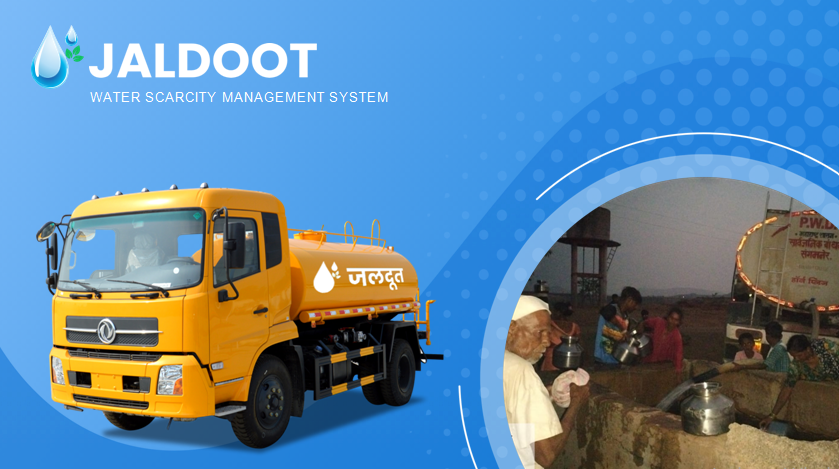JALDOOT – WATER SCARCITY MANAGEMENT SYSTEM

EXECUTIVE SUMMARY
The Jaldoot Scarcity Management System is an
innovative initiative by the Ahilyanagar District Administration to address
water scarcity through technology-driven interventions and institutional
frameworks. Launched in May 2024, it ensures equitable water distribution to
rural and semi-urban areas by optimizing tanker deliveries using GPS tracking
and a streamlined approval system. The initiative reduces delays, enhances
efficiency, and promotes transparency with real-time monitoring and precise
billing mechanisms.Local stakeholders, including panchayats, NGOs, and
self-help groups (SHGs), actively participate in identifying water-scarce areas
and creating awareness about water conservation practices. Public engagement
and feedback mechanisms ensure accountability and foster trust between the
administration and citizens.By integrating technology, community involvement,
and efficient resource management, Jaldoot has improved access to clean
water, reduced operational costs, and empowered rural communities. The
initiative serves as a sustainable, scalable, and replicable model for
addressing water scarcity challenges, significantly improving the quality of
life in affected regions.
OBJECTIVE OF THE INITIATIVE
The
Jaldoot Scarcity Management System was launched to address the critical
issue of water scarcity in Ahilyanagar district through efficient water
management and equitable distribution. Its primary objectives include:
1. Ensuring
Equitable Water Distribution:
To
provide timely and fair access to clean water in scarcity-affected rural and
semi-urban areas through a streamlined tanker management system.
2. Leveraging
Technology for Efficiency:
To
integrate technology such as GPS tracking and digital applications to optimize
water tanker routes, monitor deliveries, and ensure transparency in operations.
3. Promoting
Transparency and Accountability:
To
create a real-time tracking and monitoring mechanism that reduces
inefficiencies and prevents misuse of resources.
4. Engaging
Local Stakeholders:
To
involve panchayats, self-help groups (SHGs), NGOs, and citizens in water
distribution planning and decision-making processes.
5. Enhancing
Community Awareness:
To promote water conservation and efficient usage
through campaigns and education programs.
6. Sustainability
and Scalability:
To
establish a replicable and sustainable model of water scarcity management that
can be implemented in other regions facing similar challenges.
HOW THE INITIATIVE ACHIEVED ITS OBJECTIVES
1. Efficient
and Equitable Water Distribution:
The
Jaldoot Scarcity Management System streamlined the process of
distributing water through a well-structured tanker approval mechanism.
Villages facing scarcity were identified, and water was delivered through
scheduled and optimized routes.The use of GPS-enabled tankers ensured that
water reached the most critical areas on time while preventing route deviations
or irregularities.
2. Leveraging
Technology for Efficiency:
A
robust digital platform was implemented where proposals for water tankers were
processed in a systematic and transparent manner. Each stage—right from the
Gramsevak’s proposal to final approval by the Sub-Divisional Officer (SDO)—was
tracked using the Jaldoot application.GPS tracking of tanker movements
optimized delivery routes, reduced travel time, and ensured efficient water
supply to designated locations. An Android-based app provided real-time updates
on tanker locations, improving operational efficiency and public convenience.
3. Promoting
Transparency and Accountability:
The
initiative introduced a transparent approval process where proposals were
verified and approved step by step by relevant authorities (Talathi, BDO,
Tahsildar, SDO).Real-time tracking and digital records of tanker movements
enhanced transparency. The precise billing system ensured accountability,
preventing misuse of funds and resources.
4. Engaging
Local Stakeholders:
Panchayats
played a crucial role in identifying villages facing severe water shortages and
coordinating with district authorities.Self-help groups (SHGs) and NGOs were
actively involved in raising awareness about the initiative, mobilizing
communities to report issues, and encouraging water conservation
practices.Citizens participated through feedback mechanisms, reporting tanker
irregularities or delays and suggesting improvements for better service
delivery.
5. Community
Awareness for Conservation:
Public
awareness campaigns were conducted using local media, pamphlets, and workshops
to educate residents on water conservation and responsible usage.Training
sessions for local leaders and water management committees empowered
communities to actively participate in maintaining water resources and
preventing wastage.
6. Sustainability
and Scalability:
The Jaldoot initiative incorporated water conservation practices alongside its distribution efforts, ensuring a long-term solution to water scarcity.The modular and adaptable framework allows the system to be replicated in other districts or regions facing similar water scarcity issues.
TRANSFORMING LIVES THROUGH SYSTEMS &
INSTITUTIONAL EXCELLENCE
The
Jaldoot Scarcity Management System brings perceptible improvements to
people’s lives by introducing systematic process interventions and building
robust institutional frameworks for water distribution. By leveraging
technology like GPS-enabled tanker tracking and a streamlined approval
mechanism, the initiative ensures equitable, efficient, and transparent
delivery of water to scarcity-affected areas. Active involvement of local
stakeholders, including panchayats, NGOs, and self-help groups, empowers communities
to participate in decision-making and adopt sustainable water management
practices. This institutional approach not only addresses immediate water
scarcity but also fosters long-term resilience, improves resource management,
and enhances the quality of life for rural populations.
IMPACTS /
BENEFITS OF THE INITIATIVE
The Jaldoot Scarcity Management System has delivered significant impacts and benefits, addressing water scarcity and improving the lives of people in Ahilyanagar district. By ensuring equitable water distribution, the initiative provides timely and reliable access to clean water in rural and semi-urban areas, reducing dependency on unreliable sources. The GPS-enabled tracking system has optimized tanker routes, enhancing efficiency while minimizing delays and misuse of resources.Transparency has been improved through real-time tracking and digital approvals, ensuring accountability and precise billing for water deliveries. This has reduced corruption and built trust among citizens. The initiative also empowered local communities by involving panchayats, self-help groups (SHGs), and NGOs in water management processes.Public awareness campaigns have promoted water conservation practices, fostering long-term sustainability. Additionally, by enhancing operational efficiency, the initiative reduced costs, saving resources for both the government and citizens, and building a scalable, replicable model for water management across regions.



Comments 0 Like 0 Dislike 0